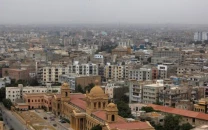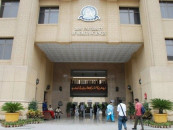Thatta’s ready, come hell or high water
Volunteers were deployed along vulnerable points round-the-clock to prevent waters from entering the district.

Thatta’s ready, come hell or high water
“We will not let a single drop submerge our land and will plug the slightest cracks along this bund,” a labourer working on one of the sensitive bunds, Surjani, said. Although continuous pressure from the river eroded three kilometres of the Surjani bund and a slight breach occurred at 6:30am on Wednesday as well, within 30 minutes they were able to contain the water. A similar seepage at Agi Mani bund was also contained in time.
Amid the rising pressure on Kotri, the district government has declared 26 points along the Indus River in Thatta as highly vulnerable. This includes the 290-km long Surjani Bund where the flood level has been recorded at 875,000 cusecs, Somda-Himalaya, Monarki, Biyu Bulel, Biyu Indo, Kakka and Agi Mani.
Volunteers were deployed along these points round-the-clock to prevent waters from entering the district. On Wednesday, they were joined by 200 Marines from the Pakistan Navy as well in an effort to speed up the work, informed Vice Admiral Tayyab Ali Dogar. The entire population around Surjani bund located in Sujawal town has been shifted to relief camps in safer locations and Section 144 has been imposed in the area for the past two days with only government officials and media persons allowed to visit.
A visit to the bund revealed that activists from both the ruling party and the opposition were also helping. “At this point we can’t afford to play politics and are here to strengthen the embankment to save our people,” a former PML-Q lawmaker and district nazim Aijaz Ali Shirazi told The Express Tribune. But locals said the Shirazis were active in the area in order to “protect their land”. This is the same embankment where a massive breach occurred during the August 1988 floods, inundating several acres of crops and affecting at least 30,000 people.
“You see Thatta has learnt its lesson from the devastation the Indus caused in the rest of the country,” says federal lawmaker Abdul Wahid Soomro. “Since we had enough time to prepare, we were able to take all the possible measures to avoid a similar catastrophe here, but the rest is in His [God’s] hands.”
After ravaging Khyber-Pakhtunkhwa, Punjab, Balochistan and Upper Sindh, the Indus has reached its final destination in Thatta from where it is expected to enter the sea, but locals fear that the sea will not be quite accommodating this time.
High tides in the sea due to full moon are expected to repel the floodwater back into the river, which may not only inundate the kachcha areas in the district, but some urban parts may also be submerged, warn officials. As a result, eight of nine tehsils in Thatta may be affected. But as the velocity of winds decreased on Wednesday, officials breathed a sigh of relief.
“These are tough days for Thatta,” provincial deputy Humera Alwani told The Express Tribune. “It has never been caught between the moon and high tides like that ever before.”
According to Thatta District Coordinating Officer Manzoor Ali Sheikh, the government has so far evacuated 80,000 people from over 352 villages in the kachcha region that face threat from the floodwaters. They have been shifted to the 160 camps established in Thatta, Keti Bandar, Gharo, Kharo Chhan, Shah Bunder, Sona Bari, Jatti and Mirpur Bathoro.
“The water level in Kotri has never risen to 950,000 cusecs. This means Thatta is in great danger,” predicted Rasool Bux, a resident of Rajoo Nizamani village that was one of the hardest-hit villages of the district.
Bux is currently seeking shelter at a camp some 20 kms away from his village, but by Wednesday they were informed by the government that will have to move further away. “It seems as if the Sindhu darya is chasing us,” he joked. Some 500 families from the Raju Nizamani village and 900 others from Tando Hafiz Shah are temporarily settled in the kachcha area near Jhirik.
In Thatta, several other villages in the kachcha area submerged near the Monarki embankment in Saeedpur area, making them inaccessible for villagers who are eager to rescue their belongings.
‘No threat to Keti Bunder, National Highway, Keenjhar Lake’
Officials have assured residents that they have taken all precautionary measures and are hopeful that floodwaters would not cause further destruction in the district.
By strengthening the bunds of K B Feeder and the bunds along the National Highway near Raju Nizamani, the irrigation authorities have succeeded in minimising the threat to the highway and Keenjhar Lake, briefed Wahid Soomro during a visit by Vice Admiral Dogar to a relief camp in Keti Bandar.
Soomro said that the Keti Bandar tehsil faced no threat either. This was confirmed by the headmaster of a high school where the camp has been established. “Only the population in the kachcha areas whose houses submerged in the floods last week is at my school,” said Abdul Majeed, who has maintained a record of IDPs on a blackboard in his room. There are 1,836 IDPs in the school.
Majeed, however, added that several others are reluctant to move to the camp because they believe “they can fight the sea”. “Keti Bandar has braved Cyclone Phet in the past. We will overcome this too,” said a fisherman, Faqeer Hussain.
But the number is expected to rise due to the panic among locals in other parts of Thatta, predicts the DCO. With the use of cell phones common in the area, a number of them are being warned by their relatives in other cities to move to safer locations. “This panic is causing more trouble than the flood itself.”
Published in The Express Tribune, August 26th, 2010.


















COMMENTS
Comments are moderated and generally will be posted if they are on-topic and not abusive.
For more information, please see our Comments FAQ